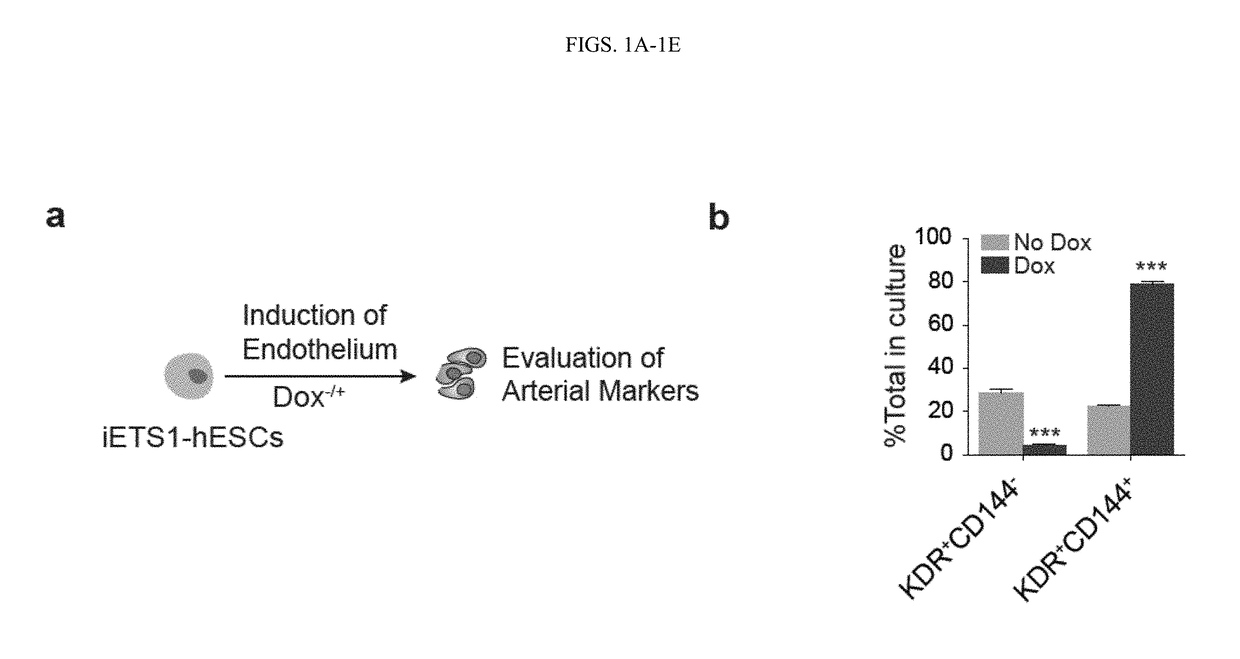Induction of arterial-type of hemogenic endothelium (AHE) and enhancement of t cell production from pscs through overexpression of ets factors or modulating mapk/erk signalling pathways
a technology of hemogenic endothelium and ahe, which is applied in the direction of genetically modified cells, antibody medical ingredients, peptides, etc., can solve the problems of significant challenge in the generation of hscs and lymphoid cells from hpscs, and achieve the enhancement of definitive hematopoiesis, enhanced production of dll4+ cxcr4+/, and enhanced definitive hematopoiesis
- Summary
- Abstract
- Description
- Claims
- Application Information
AI Technical Summary
Benefits of technology
Problems solved by technology
Method used
Image
Examples
example 1
Activation of Arterial Program Drives Development of Definitive Hemogenic Endothelium with Lymphoid Potential
[0117]This Example shows that activation of arterial program through ETS1 overexpression or by modulating MAPK / ERK signaling pathways, at the mesodermal stage of development, dramatically enhanced formation of arterial type HE expressing DLL4 and CXCR4. Blood cells generated from arterial HE were more than 100-fold enriched in T cell precursor frequency and possessed the capacity to produce B lymphocytes and red blood cells exhibiting high expression of BCL11a and □-globin. Together, these findings demonstrated that promotion of arterial specification in cultures provides a novel strategy to generate lymphoid cells and eventually HSCs from hPSCs.
[0118]De novo production of hematopoietic and lymphoid cells from in vitro expandable human cells, such as human pluripotent stem cells (hPSCs) can be used for transplantation and immunotherapies of hematologic diseases and cancers. A...
example 2
NOTCH Activation at the Definitive Mesoderm Stage Facilitates Efficient Generation of T Cells with High Proliferation Potential from Human Pluripotent Stem Cells
[0170]Adoptive T cell therapies show promise in the treatment of several types of blood cancers. Developing off-the-shelf T cell products will further advance immunotherapies to the clinic and broaden their application. Human pluripotent stem cells (hPSCs) offer the potential to serve as a versatile and scalable source of T cells for immunotherapies, which could be coupled with genetic engineering technologies to meet specific clinical needs. However, production and expansion of T cells from hPSCs remains inefficient. In order to improve T cell production from hPSCs it is essential to identify cell subsets that are highly enriched in T cell progenitors, and those stages of development at which NOTCH activation induces the most potent T cells. Previously, we have developed both OP9-based and chemically defined systems for hem...
PUM
| Property | Measurement | Unit |
|---|---|---|
| concentration | aaaaa | aaaaa |
| concentration | aaaaa | aaaaa |
| time | aaaaa | aaaaa |
Abstract
Description
Claims
Application Information
 Login to View More
Login to View More - R&D
- Intellectual Property
- Life Sciences
- Materials
- Tech Scout
- Unparalleled Data Quality
- Higher Quality Content
- 60% Fewer Hallucinations
Browse by: Latest US Patents, China's latest patents, Technical Efficacy Thesaurus, Application Domain, Technology Topic, Popular Technical Reports.
© 2025 PatSnap. All rights reserved.Legal|Privacy policy|Modern Slavery Act Transparency Statement|Sitemap|About US| Contact US: help@patsnap.com



